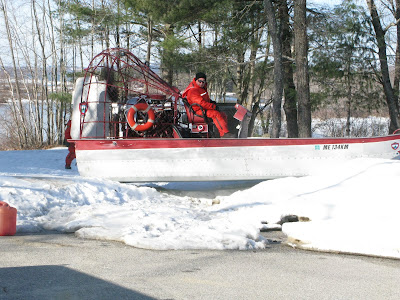 |
| (A warden submerges in the frigid waters of Sebago Lake. Photo by Katy England) |
By Katy England
edge staff writer
kengland@themaineedge.com
In a state that is locked in snow and ice for a good six months out of the year, patrolling the wilderness takes on new meaning. Especially when you consider that the Maine Warden Service dive team has to brave frigid waters in Maine year round.
The 10-person specialty team is composed of Cpl. Mike Joy (commander), Warden Bruce Loring (asst. commander), Warden Phil Richter, Warden Tony Gray, Warden Rick Stone, Warden Rick Ouellette, Sgt. Scott Thrasher, Sgt. Terry Hughes, Warden Robert Johansen and Warden Mike Pierre. There are three instructors and four dive masters.
“You need to have a knowledge of basic dive skills and the desire to be a part of the team,” said Loring. “We don’t dive alone; it’s definitely a team effort.”
He said that members should also have a willingness to learn more and further their dive skills.
Unfortunately, the dive team is usually activated not as part of search as rescue operation, but as a recovery effort in the event that someone has drowned or gone missing for a period of time in water.
In addition to recovery operations, the dive team also assists with other tasks, including inspecting state hatcheries and ensuring the intake pipes are clear and performing searches for endangered species in waterways.
The dive training is incredibly important, especially since the conditions for a dive can be extremely hostile. In addition to the cold, divers need to be aware of various concerns including air supply, depth and low visibility even in decent conditions.
“Safety is our number one concern. There are places we will not operate due to safety concerns,” said Loring.
 |
| (The Wardens' ice boat and travel over open water and ice and snow. Photo by Katy England) |
In order to keep these skills strong, the wardens conduct an annual ice dive training. This past years was conducted out on Sebago Lake on March 21 through 23. During the training, one of the simulations they performed was a “rescue the rescuer” scenario. The idea is that one of the divers encountered a problem during the dive and another diver had to locate him and bring him back to the hole in the ice. Once under the water, visibility is limited and divers are instructed to use the angle of their rope as a guide.
“We’ve conducted a search by feel only,” said Loring. “That’s why I feel that this training is extremely important. You can’t go eight to 12 months and then put them in conditions like this and expect them to perform well.”
 |
| (Wardens also practiced entering open water and swimming under the ice pack. Photo by Katy England) |
Warden Johansen has always had an interest in diving, since high school, but wasn’t able to join the dive team on the warden service until 2010 when he moved to Millinocket.
“I took a class, and that first breath of air you take when you’re under water I’ll never forget,” he said. “Being on this team is more than diving. Doing what we do is unique. It’s a challenge, but it’s fun too.”
Warden Richter has been a member of the team for 10 years and credits the fellowship on the team with getting through tough searches.
“We’re often involved in someone’s tragedy. The camaraderie helps get you through the tough times,” he said.
Throughout the training, another diver in full gear is standing by in case there is an actual problem with the simulation.
 |
| (A diver is removed from the cold waters. Photo by Katy England) |



